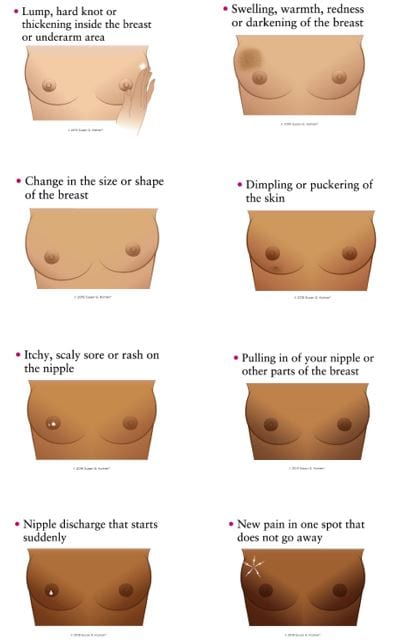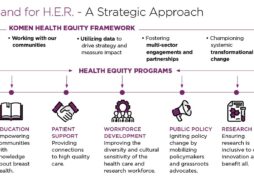Susan G. Komen recommends that anyone who has noticed an abnormality with their breasts to see a doctor. While a change in their breast could be benign (not cancer), it could also be an indication of breast cancer. Before someone can detect a change, they first must understand “what’s normal for me.”
Visible changes on the surface of our skin are typically the most common signs of breast cancer. But breast cancer can also present in the bones, liver, brain and lungs and those signs and symptoms of metastatic breast cancer (MBC) can be harder to detect because they don’t occur in the breast.
One of the best things you can do is be aware of what is normal for you – so you can recognize when something changes. A change in your breast, a pain in your body that doesn’t improve, a prolonged cough and new persistent headaches typically aren’t normal, so they should be discussed with a doctor if they don’t go away within a few weeks.
Physical changes in your breast should be checked by your doctor, too, if they don’t improve within a few weeks. These changes include:
- Lump, hard knot or thickening inside the breast or underarm area.
- Swelling, warmth, redness or darkening of the breast. A rare and aggressive form of breast cancer can look like an infection – and there may not be a lump present. This change could be an infection, or something more serious.
- Change in the size or shape of the breast. Many women have one breast that is slightly larger than the other – and that is completely normal for them. But any noticeable CHANGE in the size or shape of the breast should be reported to a doctor.
- Dimpling or puckering of the skin. This could be a dimple just like you might see in your cheek.
- Itchy, scaly sore or rash on the nipple. An unusual type of breast cancer forms under the nipple and erupts at the nipple and may look like a sore or rash or insect bite.
- Itchy, scaly sore or rash on the nipple. An unusual type of breast cancer forms under the nipple and erupts at the nipple and may look like a sore or rash or insect bite.
- Pulling in of your nipple or other parts of the breast. Some women have retracted nipples, so it’s normal that their nipples pull in. You want to look for a pulling in of the nipple that is a change in how the nipple looks.
- Nipple discharge that starts suddenly. Some nipple discharge could be due to hormones or medication. Spontaneous discharge, where clothing is damp or stained and starts suddenly, particularly if it is coming from only one breast and is clear or bloody in color, generally isn’t normal.
- New pain in one spot that doesn’t go away. We generally think that breast cancer isn’t painful – that is why it can grow and grow before being detected. However, it is possible for a cancer to cause pain. This pain is different from the general discomfort that a woman may experience in both breasts just before her period. So, a focal area of pain that doesn’t go away should be reported to a doctor.

These illustrations show changes that are obvious, but no one would want to wait until a change gets that obvious. Even subtle changes should be discussed with a doctor.
Sometimes women might notice a change and decide to “wait and see” what happens. If the change is something like pain or general “lumpiness,” she might wait until after her period to see if it goes away. If a change doesn’t go away, it’s time to get it checked.
For women who have been through breast cancer treatment, what signs and symptoms should they be looking for?
Metastatic breast cancer can happen after treatment for early stage breast cancer or in women and men who have never had breast cancer.
It is important for people to know the signs and symptoms of metastatic breast cancer. These include things like bone pain or fractures; constant dry cough or shortness of breath; pain or swelling in the belly or digestive problems; or loss of balance or seizures. Most people with these signs and symptoms don’t have MBC, but they should be checked by a doctor if the symptoms persist for 2 weeks or longer.
Why is routine medical care important for all women?
Routine medical care for those with no history of breast cancer provides an opportunity for a discussion about breast cancer risk, lifestyle habits that may increase or decrease risk, a screening plan, and for a clinical breast exam. Routine medical follow-up visits for those with a history of breast cancer provide an opportunity to discuss current concerns, side effects, signs or symptoms of local recurrence or metastasis, and routine medical care and tests.



